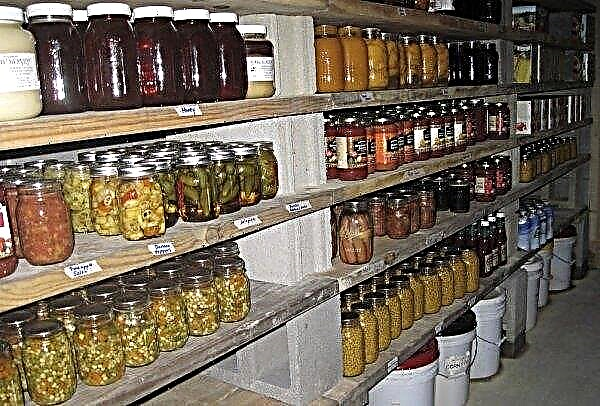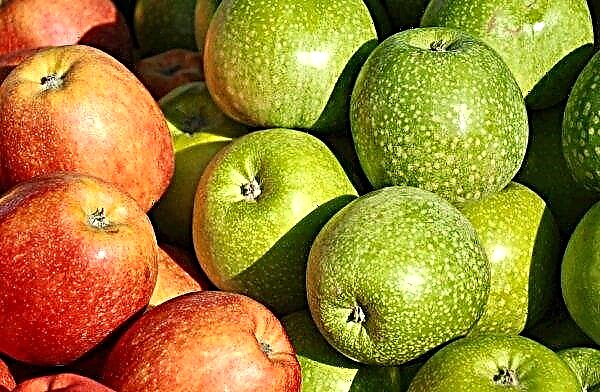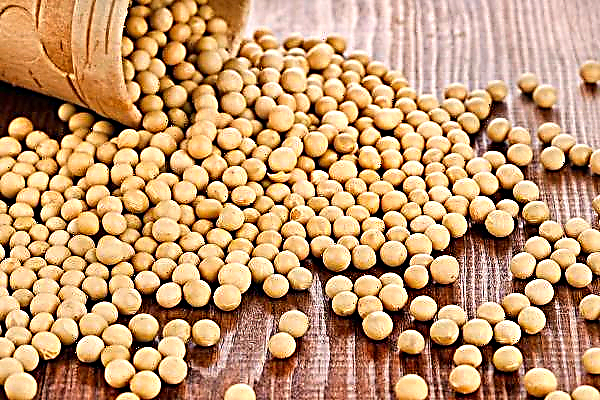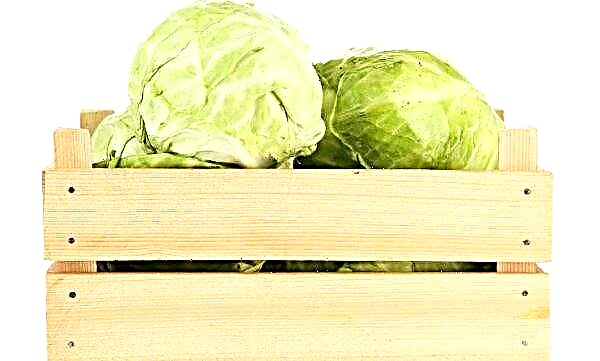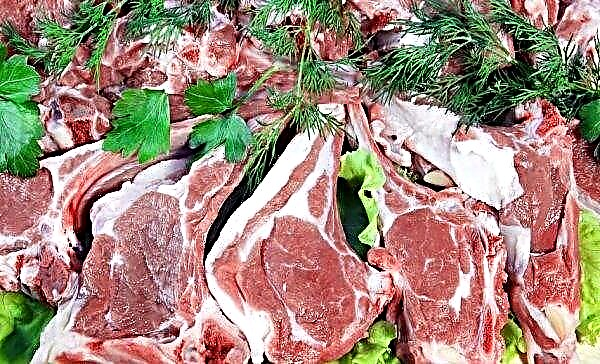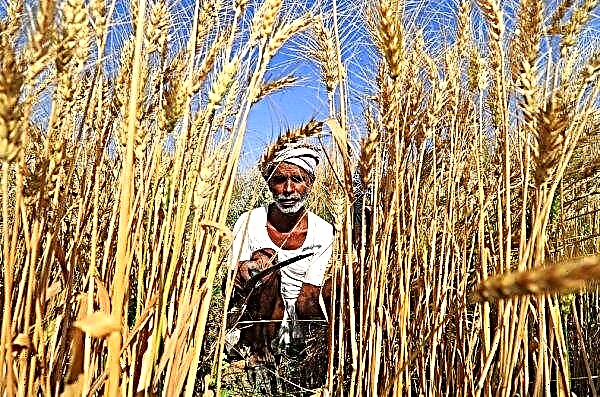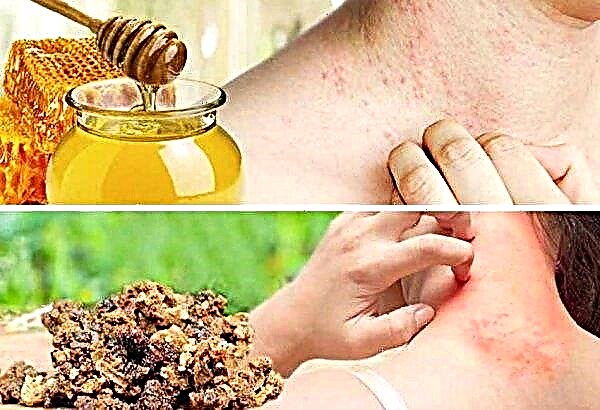Today, there are about 1.5 thousand varieties of gooseberries, which can be very difficult to choose from. The article describes and features planting, cultivating, caring for Honey variety in summer cottages and household plots.
Selection history
The Honey variety was produced by Russian breeders from the All-Russian Research Institute of Gardening named after I. Michurina. Its fruits ripen in mid-early terms - from late July to early August.
Did you know? In the twentieth century. many nations were not able to consume gooseberries, as all plantings were destroyed by a dangerous disease — powdery mildew. Breeders had to re-work on the cultivation of varieties, but many of them disappeared forever.
Description
Bushes near the gooseberry Honey grow not too high - up to 1.5 m, and not very sprawling - the diameter of the crown is a little more than a meter. A distinctive feature and the main disadvantage of the bushes is the presence of sharp spikes along the entire length of the branches.

Berries are appreciated due to their large size, mouth-watering appearance and excellent taste. They reach a mass of 4.6–6 g. They are pear-shaped. They have a thin, transparent skin through which seeds can be clearly seen. It is painted in a beautiful golden yellow color. The pulp is soft, delicate, with a sweet taste with a hint of floral honey. The sugar content in it reaches 15-17%. Tasters evaluate the taste characteristics of fruits at 4.9-5 points.
Advantages and disadvantages
- Gardeners who have already cultivated the Honey variety in their plots note the following positive characteristics in it:
- tasty and beautiful in appearance fruits;
- good winter hardiness;
- high level of productivity.
- Unfortunately, the variety is not without significant flaws, including:
- strong hissing;
- weak immunity;
- the need for mandatory trimming;
- exacting care.
Drought resistance, frost resistance
The Honey variety tolerates frosts well up to –25 ... –30 ° С. Its drought-tolerant qualities are also good.
Productivity and fruiting
After planting, gooseberries begin to bear fruit in the third to fifth year. Fruits from it can be removed for 25-30 years. From one bush annually remove up to 4 kg of berries.
Landing
The success of growing a berry culture depends on the choice of place for planting and quality care.

The timing
Gooseberries can be planted in spring and autumn. In the spring, you need to land as soon as the ground thaws, but the buds have not yet woken up. If the vegetation process has begun, it is better to postpone the planting until the fall, since a plant planted in this way will adapt and hurt for a long time.
In autumn, plant a berry culture 1–1.5 months before the onset of the first frost. So the plant will be able to adapt to growing conditions before winter and tolerate frosts well.
Choosing the right place
When choosing a place for planting gooseberry bushes, you should pay attention to such factors:
- illumination;
- hydration;
- soil composition and acidity.
An increased sugar content in fruits is possible only if the bushes are shined by the sun during most of the day. Gooseberries will not grow in a wetland, on a site where water often stagnates. The location of groundwater should not reach the soil surface closer than 1.5 m.
 The berry crop should grow in a sunny area, which does not fall shadow from tall plants and buildings.
The berry crop should grow in a sunny area, which does not fall shadow from tall plants and buildings.
Honey variety is demanding on the composition and acidity of the soil. It grows well and bears fruit only in light fertilized sandy loam and sandy soils with a neutral or slightly acidic pH reaction. In loams and clay soil, it can grow only with frequent loosening.
Selection and preparation of planting material
When buying seedlings, you should choose those that have:
- rod roots 25-30 cm long in an amount of 3-4 pieces;
- healthy, well-developed root system;
- shoots in an amount of 2-3 pieces, 20-25 cm long;
- smooth, uncracked bark.
 In order for the plant to take root faster and grow, it must be soaked in “Epin” or potassium humate.
In order for the plant to take root faster and grow, it must be soaked in “Epin” or potassium humate.
The cut under the bark should be light green in color. 2 days before planting, you should inspect the root system, remove damaged roots. If it is dry, then it must be soaked in a bucket of water for 2-3 hours. For disinfection, it is advisable to hold the root system for up to half an hour in potassium permanganate. The day before planting, it is necessary to coat the rhizome with a clay mash.
Landing pattern
During spring planting, soil preparation is done in the fall. The site is cleaned of plant debris, dug up a shovel on a bayonet, fertilizer is added for digging: rotted manure (humus, compost) (3-5 kg), wood ash (200 g), urea (25-30 g), superphosphate (45-60 g), potassium chloride (10-15 g). Alternatively, instead of mineral fertilizers make mix “Berry”.
Landing technology is as follows:
- Dig out landing holes with a depth of 35–40 cm, a width of 50–55 cm at a distance of 1.5–2 m from each other. The row spacing should be 1–1.5 m.
- Lay a drainage layer of sand and gravel 6–8 cm high at the bottom.
- Sprinkle it with a layer of fertilized soil.
- Set the seedling in the center of the pit so that the root neck is 5-6 cm below its edge.
- Cover the pit with earth to the top.
- Tamp.
- Water abundantly using a bucket of water.
- Mulch the earth with a 5–7-cm layer of peat or humus.
- Trimming - shorten each shoot, leaving 3-4 kidneys on it.

Features of seasonal care
The abundance and quality of the crop, as well as the taste of berries, depend on how well and regularly the gardener cares for gooseberry bushes. Mandatory care measures include moisturizing, top dressing, cultivating, weeding, mulching, trimming, preventive treatments against diseases and pests.
Soil care
2-3 weeks after planting, it is necessary to carry out the earthing up of seedlings. Near the stem, you need to form a mound of land 10 cm high. Watering gooseberries Honey should be infrequent, but plentiful. It is important that the plant does not suffer from a lack of moisture during flowering and fruit setting. Also, water-loading irrigation is required before winter. On average, 30-50 liters are spent per bush.
Important! Since gooseberries have a superficial root system, they should be extremely careful during cultivation so as not to damage it. The depth of the procedure should not exceed 7 cm.
Humidify the bushes under the root. However, the best way to water is drip. After each irrigation and rain, the trunk area should be loosened. This is required to prevent the appearance of a hard crust on the surface of the earth, preventing the normal flow of moisture and air to the roots.
Do not ignore weeding. Weed herbs must be removed in a timely manner to prevent the reproduction of harmful insects and pathogens. To reduce the amount of watering, loosening and weeding allows a procedure such as mulching.
 Mulch from compost, peat, mowed grass maintains the necessary level of soil moisture and inhibits the growth of weeds.
Mulch from compost, peat, mowed grass maintains the necessary level of soil moisture and inhibits the growth of weeds.
Preventative treatment
Gooseberry Honey is susceptible to infection by many diseases and poorly resists the attacks of harmful insects. Therefore, mandatory care measures include preventive spraying and treatment.
You should adhere to the recommendations for prevention given in the table:
| Period | What disease or pest | Treatment Options |
| In the spring | Powdery mildew |
|
| Before budding | Anthracnose |
|
| Before budding | Septoria |
|
| In the spring | Rust |
|
| Before budding | Fire |
|
| During the budding period, after flowering | Moth |
|
| After flowering | Glassmaker |
|
| When leaves appear and during flowering | Gallitsa |
|
| Since the end of may | Aphid |
|
| Before the buds, after the buds fall | Spider mite |
|
Top dressing
High yields can only be achieved with regular fertilizer application. Gooseberries are fed with organic and mineral mixtures in the spring, summer and autumn.
Annually in spring, before the buds bloom, you need to make a mixture of urea (50–70 g) with boric acid (25–30 g) diluted in a bucket of water under the root in moistened soil. Such an amount will be needed to fertilize one bush. Alternatively, you can make manure diluted with water in a ratio of 1 to 4.
Once every 2 years it is recommended to feed gooseberry plantings with rotted manure, humus or compost (4-5 l) mixed with superphosphate (50 g), potassium chloride or potassium nitrate (20 g), wood ash (1 tbsp.). This quantity of substances is calculated on 1 m².

In summer, in early June, gooseberries need ready-made complex mineral mixtures, for example, “Berry”, “Stimul-1”, “Biohumus”. Among the options for summer top dressing are also slurry (with water 1 to 5), a mixture of nitrophoska (20–25 g) and potassium humate (35–40 g) diluted in a bucket of water.
Fall in order to strengthen the bushes before winter, complex mixtures containing phosphorus and potassium, for example, Autumn, Nitrophos, are introduced into the soil. You can also use manure diluted with water in a ratio of 1 to 10 or bird droppings.
Support
To exclude contact of the lower branches with the ground and thereby reduce the risk of developing fungal diseases, it is advisable to establish supporting supports.
Pruning
Trimming is a very important procedure that should never be ignored. If you do not prune the shrubs, then soon they will begin to produce small fruits with a sour taste, and the fruiting period will be postponed to a later date. It is also a good prevention against the development of diseases.
 Traces of sections are treated with copper sulfate (10 g / 1 liter of water) and garden var.
Traces of sections are treated with copper sulfate (10 g / 1 liter of water) and garden var.
They trim 2 times a year - in spring and autumn. During the procedure, all old (older than 5–7 years old), damaged, diseased, dry, curved branches are removed. Pruning is done with a sanitized garden tool.
Harvesting and storage
Start harvesting berries that are planned to be consumed fresh should be when they reach the variety, size, color and taste specified in the description. If the fruits are further processed, then they can be harvested in a state of technical maturity, i.e., sour. Gooseberries can be cleaned by hand, using a comb or a special vibrator. Summer residents and homeowners often resort to the first two methods.
 Gooseberry is not stored for long. Finally ripened berries are able to lie in the refrigerator for only 4 days. Unripe - up to 10 days.
Gooseberry is not stored for long. Finally ripened berries are able to lie in the refrigerator for only 4 days. Unripe - up to 10 days.
When manually collecting hands, it is imperative to protect with gloves, and the body with clothes with long sleeves. To remove the berries, the branch should be lifted with one hand and the other to pick them along with the stalks. You can buy a comb in a specialized store or make it yourself. The device is put on the thumb, held him on a branch and pluck several berries at the same time without a stalk.
If completely dry fruits are stored at a temperature of 0 ° C, then the period of their use is extended to 1.5 months. To be able to eat healthy berries throughout the winter and spring, they should be frozen. To transport the crop, you must use a small container - up to 2.5 liters. It is better to tolerate the transportation of fruits that are immediately after collection have been cooled.
Did you know? Residents of Russia began to grow gooseberries earlier than Europeans. Starting from the 11th century they planted him in the gardens of the monasteries.
Winter preparations
In order for the plant to tolerate winter frosts normally, it must be properly prepared. Preparatory measures include:
- pruning
- top dressing;
- preventive treatment against diseases and harmful insects;
- mulching the soil.
In the fall, after removing the fruit, it is necessary to carry out sanitary pruning. During it, all broken, sick, dried, old, deformed branches are cut out. On each bush, no more than 10-15 shoots must be left. The next step is fertilizing with organic and mineral fertilizers. About the recommended composition we mentioned above.
 If there is a risk of attack by rodents, then you need to shelter with spruce branches, burlap, spanbond.
If there is a risk of attack by rodents, then you need to shelter with spruce branches, burlap, spanbond.
Since harmful insects and pathogens winter in the soil and bark, in order to prevent their wintering, shrubs should be sprayed with systemic fungicides and insecticides. Complete the preparation by mulching the soil. In the aisles and in the near-stem zone, a 10-centimeter layer of humus or peat is laid. No additional shelter for gooseberries is required. You just need to cover it with snow. If the snow cover is insufficient, then it is worth covering the plantings with agrofibre.
Breeding methods
Gooseberry Honey is best propagated in two ways:
- Layering.
- Green cuttings.
Most often, gardeners resort to reproduction by layering. This is the easiest and fastest way. To reproduce successfully, choose a strong shoot, which turned 2 years old. It must be dug into the furrow, secured with a bracket and periodically moistened. After rooting, usually in the spring of next year, layering can be separated from the parent plant.

Green cuttings 20 cm long are cut from the beginning to mid-July. They need to be planted in a peat-sand substrate for rooting, deepening by 2 cm, after having previously stood in the root-forming agent. To maintain the necessary microclimate - temperature + 27 ° С and humidity 90% - it is necessary to organize a mini-greenhouse. After rooting, the cuttings can be planted in a permanent place. Propagation by lignified cuttings is undesirable, since their rooting is difficult.

Diseases and Pests
The following diseases can pose a threat to Gooseberry Honey:
- Powdery mildew . A characteristic sign of infection is a white coating, similar to flour, on leaves and shoots, which subsequently acquires a grayish tint. Leaves bend, bushes stop growth and die if untreated.

- Anthracnose. When infected, small brown spots with tubercles form on the leaves. To cure the disease, resort to spraying "Nitrofenom", copper sulfate, Bordeaux liquid.

- Septoria. The disease manifests itself as brown spots on the leaves, which, as it develops, become white with a dark border. Treatment is done with drugs "Nitrofen", "Tsineb", "Kaptan", Bordeaux liquid, copper sulfate.
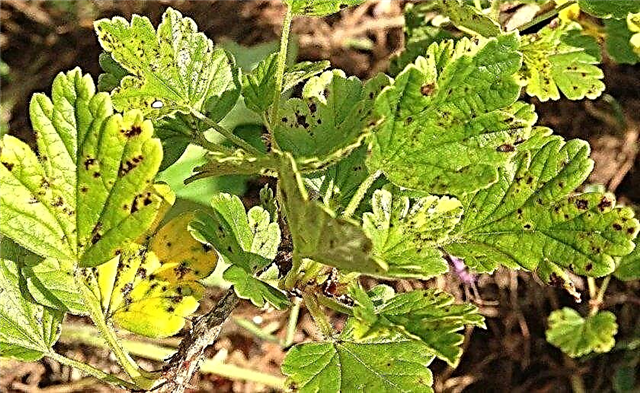
- Rust. Symptoms can be detected on the lower leaf plate - there appear convex yellow spots. The disease is difficult to treat, therefore it is necessary to resort to preventive spraying.

- Mosaic. The main symptom is light green spots on the leaves. Mosaic is not treated. It can only be warned. If infection occurs, diseased bushes need to be uprooted and burned.
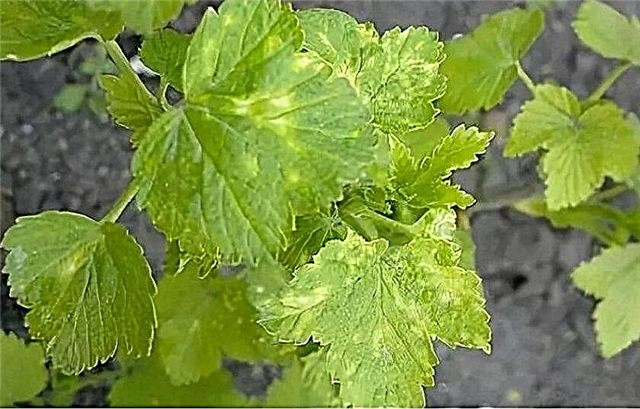
Important! Chemical spraying should be carried out on a day when it is not hot and there is no sun, precipitation and wind, or in the evening in calm weather.
Of the pests for berry culture the most dangerous are:
- Sawfly. The insect eats foliage and young shoots, which causes severe damage to the plant.Against this insect, it is imperative to carry out preventive measures. In case of infection, resort to spraying with drugs "Bitoxibacillin", "Lepidocide", "Inta-Vir", "Decis".
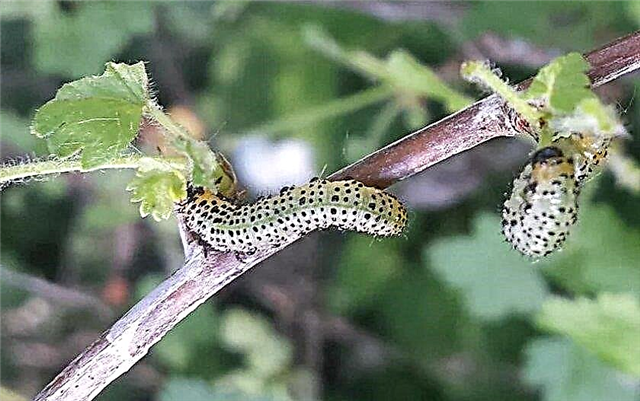
- Fire. Larvae of a butterfly-firefly gnaw out from within the ovary, resulting in significantly reduced productivity. In order not to let the butterfly enter the garden, you should plant mint or tomatoes nearby, the smell of which scares it away. With the defeat of gooseberry bushes, it is necessary to use drugs “Bitoxibacillin”, “Iskra”, “Karate”, “Actellik”, “Karbofos”.

- Moth. Leaf parasite. Able to destroy them in a short time, leaving only one vein. Spray is used to combat harmful insects. “Actellicus”, “Karbofos”.

- Gallitsa. Characteristic signs of infection: dark cracked spots on the bark, dried and blackened leaves, fallen buds. Of folk remedies against gall midge, mint and tomato tops infusions are used. From chemicals - Actellik, Karbofos.
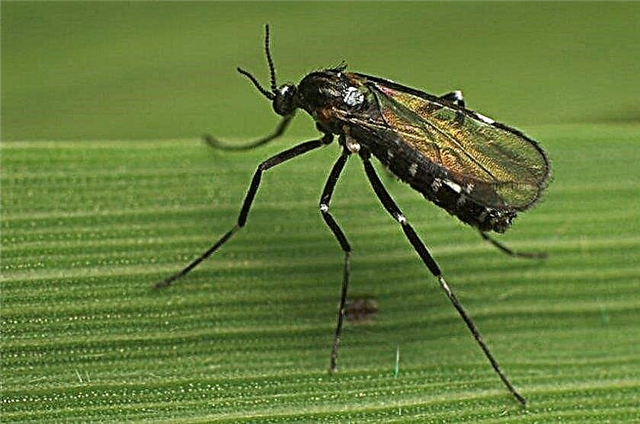
- Glassmaker. Severely damages the shoots. Treatment must be carried out “Actellicus” or “Karbofos”. During trimming, you need to process the places of cuts with copper sulphate, garden var or a tool "RunNet".
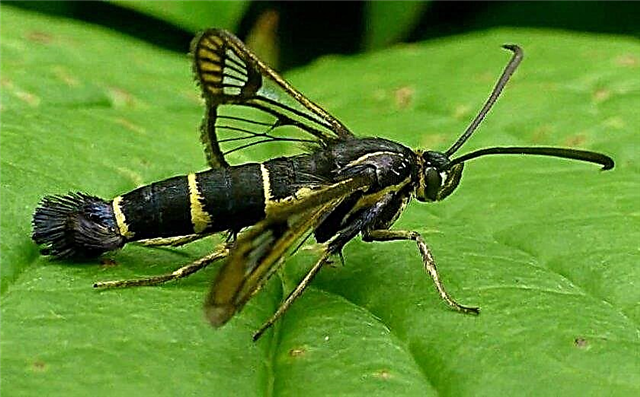
- Aphid. A sucking insect feeding on plant juices. The presence of aphids is indicated by dry leaves, stopping and deformation of the shoots. With a slight infection, they resort to using a decoction of tomato tops, garlic infusion, soap solution, mustard infusion. If there are too many insects, then you need to connect chemicals, for example, Fitoverm, Aktaru, Iskra, Inta-Vir.
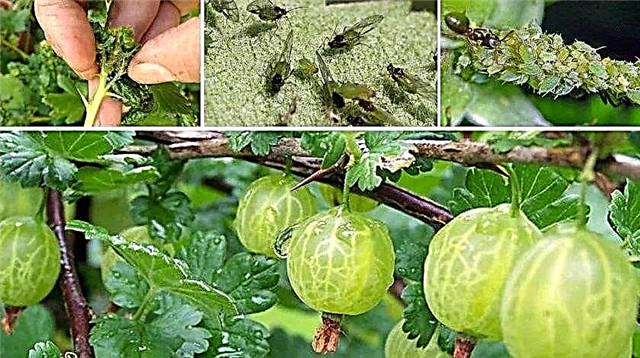
- Spider mite. Like aphids, it drinks vegetable juice. A characteristic symptom of its harmful activity is the presence of a web on the plant. Acaricides fight the tick “Akartan”, “Metaphos”, “Phosphamide”.
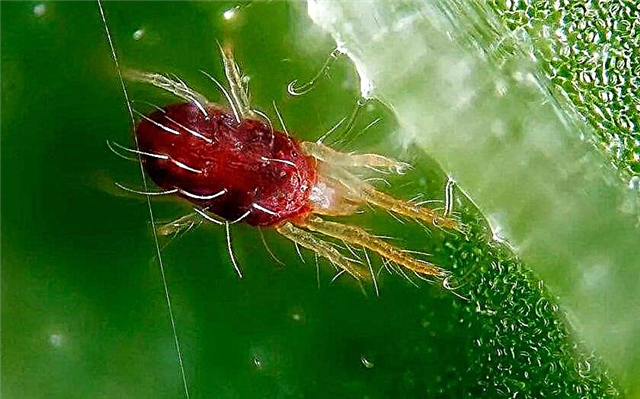
So, the gooseberry Honey is appreciated because of tasty and beautiful berries, however care of it is difficult. In addition, the plant is characterized by strong hissing, which complicates the process of harvesting. If you do not have the time and desire to work a lot in the garden, then it is better to look at other varieties, more unpretentious and non-bearing.













